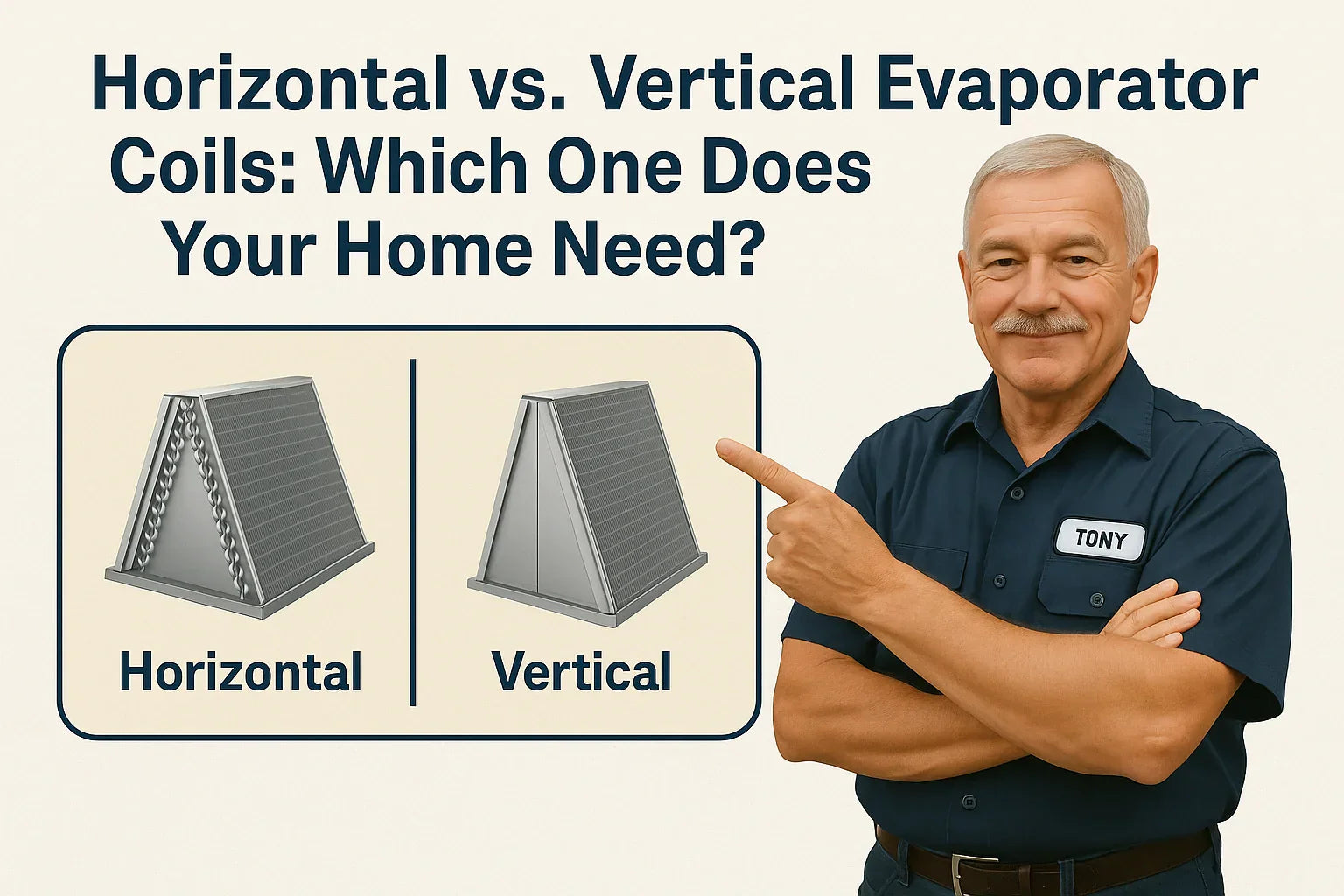Introduction: Orientation Matters More Than You Think
When shopping for a new evaporator coil, most homeowners focus on size, brand, or price. But one of the most important (and most overlooked) decisions you’ll face is coil orientation: horizontal or vertical?
Choosing the wrong orientation can lead to poor airflow, inefficient cooling, moisture issues, and even system failure over time. As always, Tony’s here to break down the technical jargon and give you a homeowner-friendly guide to choosing the right coil orientation for your home.
What Does Coil Orientation Mean?
Simply put, coil orientation refers to the direction air flows across your evaporator coil inside the air handler or furnace:
-
Vertical Coil: Air flows vertically (up or down) through the coil.
-
Horizontal Coil: Air flows horizontally (side-to-side) through the coil.
Your home’s ductwork layout, HVAC configuration, and available space typically dictate which orientation you need.
Why Coil Orientation Is So Important
-
Proper Airflow: Mismatched orientation disrupts airflow, reducing system efficiency.
-
Drainage: Correct orientation ensures condensation drains properly from the coil.
-
Space Constraints: Orientation must fit your air handler's available footprint.
-
System Longevity: Improper orientation stresses your system, potentially shortening its lifespan.
Energy Star - HVAC System Design Basics
Vertical Evaporator Coils: Best for Traditional Homes
What They Are:
-
Installed upright in a vertical air handler or furnace.
-
Air moves from bottom to top (upflow) or top to bottom (downflow).
Best For:
-
Homes with basement or closet installations.
-
Systems where ductwork runs above or below the air handler.
-
Traditional split systems.
Pros:
-
Excellent drainage of condensation.
-
Natural airflow alignment in most homes.
-
Easier maintenance access.
Cons:
-
Requires vertical clearance.
-
Not ideal for tight attic or crawlspace installations.
Typical Sizes Available:
-
1.5 to 5 tons capacity (matching most residential systems).
Horizontal Evaporator Coils: Best for Tight Spaces
What They Are:
-
Installed sideways in a horizontal air handler.
-
Air flows from one end of the coil to the other horizontally.
Best For:
-
Attics, crawlspaces, and tight mechanical rooms.
-
Homes without basements.
-
Southern climates with more attic installations.
Pros:
-
Fits into tight spaces.
-
Compatible with many air handlers designed for low-clearance installation.
Cons:
-
More prone to drainage problems if not installed level.
-
Harder maintenance access for cleaning coils.
Typical Sizes Available:
-
1.5 to 5 tons (same as vertical coils).
Cased vs. Uncased Coils (Applies to Both Orientations)
Cased Coils:
-
Factory-sealed metal housing around the coil.
-
Easier installation.
-
Better protection from dirt and debris.
-
Preferred by most HVAC contractors.
Uncased Coils:
-
Open coil without outer housing.
-
Allows custom fitting for unique installations.
-
Often used in retrofits or space-limited projects.
Drainage: The Silent Killer of Poor Orientation
Incorrect orientation can cause improper condensate drainage, leading to serious issues:
-
Water leaks
-
Mold and mildew growth
-
Freeze-ups due to backlogged moisture
-
Corrosion of equipment
-
Structural water damage
A properly installed horizontal coil must be level and include secondary drain pans or float switches to protect your home.
EPA - Indoor Moisture Problems
Installation Considerations By Home Type
| Home Type | Recommended Orientation |
|---|---|
| Basement HVAC | Vertical Upflow |
| Closet HVAC | Vertical Upflow or Downflow |
| Attic HVAC | Horizontal |
| Crawlspace | Horizontal |
| Slab Homes | Usually Horizontal |
SEER Efficiency Considerations
-
Coil orientation does not directly impact SEER rating.
-
However, improper airflow due to poor orientation can lower actual operating efficiency.
-
Always ensure your coil matches your system's designed airflow and tonnage.
Tony’s Tip: "Even a high-SEER system won’t perform well if air isn’t moving right. Orientation matters as much as efficiency ratings."
Energy.gov - Air Conditioner Performance Factors
Cost Differences Between Horizontal and Vertical Coils
| Factor | Vertical Coil | Horizontal Coil |
| Coil Price | $500 - $1,200 | $600 - $1,400 |
| Installation Labor | $700 - $1,500 | $800 - $2,000 |
| Total Installed Cost | $1,200 - $2,700 | $1,400 - $3,400 |
-
Horizontal installs may cost slightly more due to access difficulties.
-
Custom retrofits (especially uncased horizontal) can drive costs higher.
Real-World Homeowner Scenarios
Scenario 1: Vertical Install in Midwest Basement
-
Location: Illinois
-
System: Goodman 3 Ton 15.2 SEER2 Heat Pump
-
Install Type: Vertical Upflow in basement furnace
-
Cost: $1,800 installed
Scenario 2: Horizontal Install in Florida Attic
-
Location: Florida
-
System: Carrier 2.5 Ton 16 SEER2 AC
-
Install Type: Horizontal air handler in attic with secondary drain pan
-
Cost: $2,700 installed
Scenario 3: Tight Crawlspace Retrofit
-
Location: North Carolina
-
System: Rheem 4 Ton Heat Pump
-
Install Type: Uncased horizontal coil custom fit
-
Cost: $3,200 installed
Tony’s Take: What I Tell My Customers
"This decision isn’t just about what’s cheaper or what’s available online. It’s about what fits your house, your ductwork, and your long-term comfort. A proper fit today means fewer headaches for you tomorrow. Don’t guess—get an experienced tech to evaluate your system’s layout."
Questions to Ask Your Contractor Before Choosing Coil Orientation
-
Which orientation does my current system use?
-
Will my ductwork need modifications?
-
How will drainage be handled?
-
Are secondary drain pans or safety switches included?
-
Will this installation meet local code requirements?
Conclusion: Orientation Is a Critical (and Easy to Overlook) Decision
The choice between horizontal and vertical evaporator coils isn’t just a technicality—it’s a critical decision that impacts your system’s performance, efficiency, maintenance, and long-term reliability.
When you work with trusted suppliers like The Furnace Outlet, you’ll find clear labeling and expert guidance to ensure you select the correct orientation for your specific home configuration.
In the next article we will know about: How to Clean and Maintain Your Evaporator Coil for Maximum Efficiency







